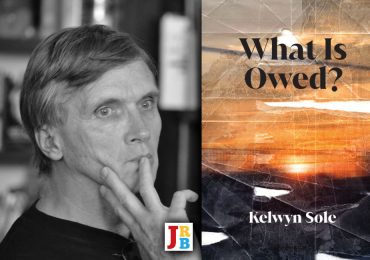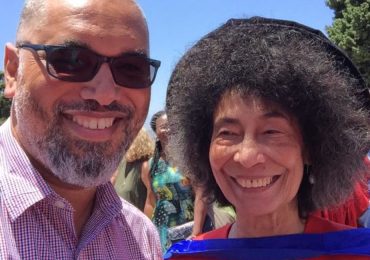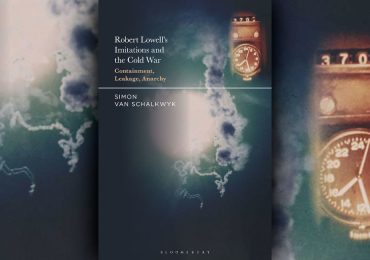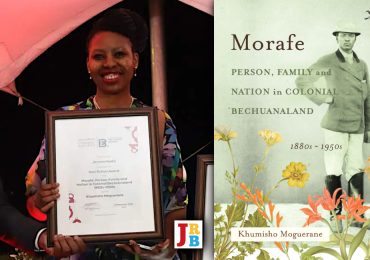The JRB presents an excerpt from Dying for Freedom: Political Martyrdom in South Africa, the new book by Jacob Dlamini.
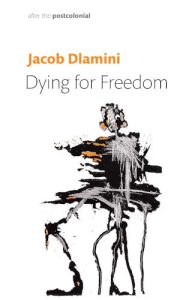
Dying for Freedom: Political Martyrdom in South Africa
Jacob Dlamini
Polity, 2024
The Unmournable Death
Jacob Dlamini died a gruesome death. (1) He and his wife Masabata were at home in Sharpeville when a group of residents attacked them. It was early spring, September 3, 1984, and the residents were protesting against a rent increase introduced two days earlier by the Lekoa Town Council, of which Dlamini was deputy mayor. The township, 70 kilometres south of Johannesburg, had been tense since August 5 when Dlamini announced the spike at a public meeting. The Dlaminis, expecting trouble since the announcement, had sent their children, two boys aged twelve and four, and a girl aged seven, to Masabata’s parents’ house nearby.
As the residents marched past the Dlamini residence on their way to the council’s offices that morning, some pelted the house with stones. Police in armored cars arrived and dispersed the crowds, using tear gas and rubber bullets. The police asked Dlamini to come with them for his own safety. ‘Poignantly, perhaps bravely, certainly unwisely,’ he refused. (2) The police left. Fifteen minutes later, the residents regrouped and began stoning Dlamini’s house again. Masabata, who would lose her mind as a result of the attack, fled to next-door neighbor Tshepo Stoffel Maile’s house and hid in a wardrobe. Dlamini came out armed with a 9mm Star pistol. He fired into the crowd, injuring one woman. He went back inside. The residents continued to attack. Someone threw a petrol bomb through a window. Dlamini, still armed, ran outside.
Three individuals, never identified, ran after Dlamini as he tried to jump over the wire-mesh fence that separated his yard from Maile’s. They wrestled him to the ground outside Maile’s kitchen door, took his gun and began assaulting him. Other residents joined in. They stoned Dlamini around the head, knocking him out. As Dlamini lay unconscious outside Maile’s door, some individuals pushed Dlamini’s Toyota Cressida out of his garage and onto the street. They turned the car on its side and set it alight. Two people dragged Dlamini’s limp body to his burning car. They set him alight. He was alive but unconscious. By 1 p.m., when the police returned, Dlamini was dead.
Dlamini was among fifty people, four of them town councilors, killed around the Vaal Triangle townships of Sharpeville, Sebokeng, Boipatong and Bophelong that day. The police killed most of the fifty, but some, like Dlamini, died at the hands of residents protesting against municipalities such as the Lekoa Town Council, government institutions intended to give black South Africans limited political control over their lives. The events of September 3 came four months before ANC president Oliver Tambo called on black South Africans to render South Africa ungovernable. (3)
Dlamini was among the estimated 25,000 people who died in the apartheid conflict in South Africa between 1960 and 1994. Of the 25,000, 16,000 were killed in the period 1985–95 during clashes between supporters of the ANC and the government-backed Inkatha Freedom Party; about 5,000 were killed by the police and about 1,000, including Dlamini, died as a result of burnings and necklacings. (4) The majority of those subjected to such fiery ends died because individuals in their communities considered them collaborators and traitors: collaborators with the apartheid regime; traitors to the cause of black liberation. Dlamini died because he was, in the words of Peter Parker and Joyce Mokhesi-Parker, ‘an enemy of the people.’ (5)
But who were ‘the people’ that Dlamini betrayed? Were they his neighbors? His constituents in Sharpeville? Or blacks in general? As Tobias Kelly and Sharika Thiranagama remind us, claims of betrayal carry no self-evident truth. ‘Any act of treachery can also be a potential act of loyalty to another cause.’ (6) Maile, who saved Masabata’s life, remembered Dlamini as someone who valued education. But he also recalled an arrogant man who thrived on conflict. ‘He was power; he was killed by power,’ Maile said. (7) But other neighbors remembered him differently. Paulina Ramagole said: ‘He was a good man. He did not look down on us.’ She said Dlamini would MC at local funerals and would take the elderly to Sun City, a leisure resort 210 kilometres away from Sharpeville, for holidays. (8) ML Netshivhale said Dlamini would distribute maize and sugar to pensioners. ‘He was a Christian,’ she said. Recalling the day of Dlamini’s death, Sarah Moeketsi said: ‘That was a sad day. I don’t want to remember that day.’ (9)
What, then, was Dlamini’s cause? Where did his political loyalties lie? It has been forty years since Dlamini was killed, but how we answer these two questions has important implications for how we think about the nature of the struggle for freedom in South Africa as well as the place of death in that fight. Was this a civil rights struggle in which blacks fought valiantly for the extension of political rights to all South Africans? Or was it a revolution intended to upend apartheid and replace it with something different? Could one use peaceful means to fight apartheid or was the system such that only arms could defeat it? At the heart of these questions is one key implication: Depending on the answers that a person gave, he could justify serving in apartheid institutions, or make an argument about why these institutions could not be reformed and had to go.
To be sure, the apartheid government did not introduce black local government to South Africa. From the very beginning of what would become South Africa, European settlers tried different techniques to assert their political authority. These methods depended on the cultivation of African allies or the co-option of institutions of traditional African authority. They also relied on the invention of African traditions through the ‘accommodation of patriarchs.’ (10) In effect, European patriarchs would decide with the help of their African counterparts what was African custom. Through this accommodation, European men asserted their authority over all Africans while their male African allies claimed power over African women and subordinate men. (11)
However, different African actors saw opportunity in the public bodies that colonial and apartheid authorities created. For example, many of the founder members of the ANC participated in institutions such as iBhunga in the Eastern Cape, the Natives Representative Council, the traditional authorities that became the basis for bantustans, as well as municipal councils around South Africa. For the first half of the twentieth century, participation in these bodies enjoyed some legitimacy among blacks. However, after the advent of apartheid in 1948, these institutions lost credibility. By the 1970s, when Dlamini was a councilor, they were thoroughly discredited.
It would be easy to say Dlamini was a victim of circumstance, caught between an illegitimate government and a disenfranchised populace. However, that would be to deny the personal and political choices that led him to a seat on the Lekoa Town Council in the first place. We could say, as did lawyer Prakash Diar, that Dlamini was ‘obstinate to the point of stupidity,’ but blaming Dlamini for his own death is not a satisfactory explanation. (12) We could say he was in the wrong place at the wrong time, but we would be hard-pressed to explain how a man could be in the wrong place in his own home.
We could say, as Tambo suggested in the 1985 speech referred to above, that people like Dlamini were puppets, driven into the proverbial dustbin of history by the masses. (13) That, too, would be to simplify matters. It would be to ignore the complex web of relations between Dlamini and his community, including those who did not vote for him. The fact that the so-called black local authorities were unpopular did not mean that, as might have been the case with Solidarity in Poland or dissidents in East Germany in the 1980s, residents of Sharpeville could live ‘as if’ the local authorities and the apartheid government behind them did not exist. (14)
This is not to deny that Dlamini and his council were unpopular. The township had about 160,000 adults in 1983. About 100,000 registered to vote in the 1983 elections that ushered in black local authorities such as the Lekoa Town Council. But only 14,321 of registered voters turned out in the November 1983 elections that put Dlamini in office—a 14 per cent turnout. (15) Dlamini, who began his political career in 1977 when he joined the Sharpeville Town Council, a forerunner to the Lekoa Town Council, was a schoolteacher, a profession considered historically the bastion of the black middle class in South Africa. When he joined the council, he served on two committees: one handled housing, the other trade. These were powerful committees. They offered endless opportunities for corruption. Dlamini allegedly took bribes and used his position to enrich himself. By 1984, he owned a petrol station and a soccer club. This in a township with the highest cost of living in South Africa. (16)
Dlamini won election as deputy mayor in 1983 on the back of promises to improve the lot of the elderly and to reduce rents. He promised to get pensions delivered to people’s homes. (17) This was a hit with pensioners, even if it did not endear him to most residents. As one of his supporters, an elderly woman named Cornelia Sefadi, explained, Dlamini understood old voters. ‘He would buy us groceries … He always told the elderly to speak for themselves.’ (18) Dlamini clearly had supporters. But she also remembered him as reserved, ‘not one for chit-chat.’ (19)
If Dlamini died because he was an apartheid stooge, if he was killed because he was, in the eyes of his assailants, a sell-out, what was the substance of his collaboration? Was it his corruption? His arrogance? His membership of an unpopular council? Or was it because he was a black man active in an apartheid institution? Did he die because he was the public face of apartheid in Sharpeville? Raising these questions takes us into what Chiara Lepora and Robert Goodin call the ‘messy moral landscape’ of complicity. (20)
Notes
1. The following reconstruction is based on archival sources as well as on interviews with Dlamini’s neighbors. See Wits University’s Historical Papers, Sharpeville Six, AK2243, vols. 2–5. I am grateful to Gaby Mohale, Michelle Pickover and their colleagues for their help. I am not related to Jacob Dlamini.
2. Edwin Cameron, ‘When judges fail justice,’ Current Legal Problems, vol. 58, no. 1 (2005), pp. 83–99, p. 84.
3. Oliver Tambo, ‘Render South Africa ungovernable,’ message to the National Executive Committee of the African National Congress on the seventy-third anniversary of the ANC, January 8, 1985, http://www.anc.org.za/content/message-oliver-tambo-national-executive-committee-african-national-congress-73rd-anniversary, accessed January 31, 2011.
4. See Final Report of the South African Truth and Reconciliation Commission, Cape Town: CTP Printers, 1998. See especially vols. 3 and 4.
5. Joyce Mokhesi-Parker and Peter Parker, In the shadow of Sharpeville: Apartheid and criminal justice, New York: New York University Press, 1998, p. 12.
6. See Tobias Kelly and Sharika Thiranagama, ‘Introduction,’ in Traitors: Suspicion, intimacy and the ethics of state-building, Philadelphia: University of Pennsylvania Press, 2012, pp. 1–23, p. 1.
7. Interview with Stoffel Maile, Sharpeville, January 2011.
8. Interview with Paulina Ramagole, Sharpeville, January 2011.
9. Interview with Sarah Moeketsi, Sharpeville, January 2011.
10. See Jeff Guy, ‘An accommodation of patriarchs: Theophilus Shepstone and the foundations of the system of native administration in Natal,’ Journal of Natal and Zulu History, 2018, vol. 32, no. 1, pp. 81–99.
11. See ibid., p. 81.
12. Prakash Diar (with L. Vogelman), The Sharpeville Six: The South African trial that shocked the world, Toronto: McClelland & Stewart, 1990, p. xxv.
13. See Oliver Tambo, ‘Render South Africa ungovernable.’
14. I borrow this idea from Tina Rosenberg (1995) and Timothy Garton Ash (1997). See Rosenberg’s The haunted land: Facing Europe’s ghosts after communism, New York: Random House, 1995, and Ash’s The file: A personal history, London: Vintage, 1997
15. Prakash Diar, The Sharpeville Six, p. xviii.
16. Ibid.
17. Ibid., p. xxii.
18. Interview with Cornelia Sefadi, Sharpeville, January 2011.
19. Ibid.
20. See Chiara Lepora and Robert Goodin, On complicity and compromise, Oxford: Oxford University Press, 2013, p. 6.
~~~
- Jacob Dlamini is Associate Professor of History at Princeton University. He is the author of Native Nostalgia, Askari: A Story of Collaboration and Betrayal in the Anti-Apartheid Struggle, for which he won the Sunday Times Alan Paton Award, The Terrorist Album and Safari Nation, which won the University of Johannesburg Prizes for South African Writing in English.
~~~
Publisher information
What happens when death becomes the ultimate marker of one’s commitment to one’s freedom? What happens when the opposite of freedom is not unfreedom but death, not slavery but mortality? How are we to think of the right to life when a political demand for dignity and honor might be more important than life itself?
Dying for Freedom explores these questions by drawing on archival evidence from South Africa to show how death and conflicting notions of sacrifice dominated the struggle for political equality in that country. This political investment in death as a marker of commitment to the anti-apartheid struggle encouraged a masculinist style of politics in which the fight for freedom was seen and understood by many activists as a struggle literally for manhood. This investment generated a notion of political sacrifice so absolute that anything less than death was rendered suspect. More importantly, it resulted in a hierarchy of death whereby some deaths were more important than others, and where some deaths could be mourned and others not.
This highly original account of the necropolitics of the liberation struggle will be of interest to students and scholars throughout the humanities and social sciences and to anyone interested in South Africa.

